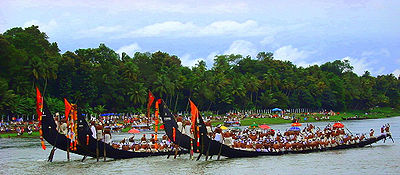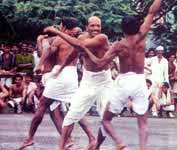
King Mahabali & Onam
The legend of King Mahabali is the most popular and the most fascinating of all legends behind Onam. Onam celebrates the visit of King Mahabali to the state of Kerala every year. The festival is celebrated with fervour as King Mahabali is greatly respected by his subjects. King Mahabali is also popularly called Maveli and Onathappan.
Reign of King Mahabali
The story goes that the beautiful state of Kerala was once ruled by an Asura (demon) king, Mahabali. The King was greatly respected in his kingdom and was considered to be wise, judicious and extremely generous. It is said that Kerala witnessed its golden era in the reign of King Mahabali. Everybody was happy in the kingdom, there was no discrimination on the basis of caste or class. Rich and poor were equally treated. There was neither crime, nor corruption. People did not even lock their doors, as there were no thieves in that kingdom. There was no poverty, sorrow or disease in the reign of King Mahabali and everybody was happy and content.
Brief Sketch of King Mahabali
It may be noted Mahabali was the son of Veerochana and grandson of Prahlad, the devout son of demon King Hiranyakashyap. Mahabali had a son called Bana, who became a legendary king in his own right and became popular as Banraj in central Assam. Mahabali belonged to the Asura (demon) dynasty but was an ardent worshiper of Lord Vishnu. His bravery and strength of character earned him the title of “Mahabali Chakravathy” or Mahabali – the King of Kings.
Challenge for Gods
Looking at the growing popularity and fame of King Mahabali Gods became extremely concerned and jealous. They felt threatened about their own supremacy and began to think of a strategy to get rid of the dilemma.
To curb the growing reign of Mahabali and maintain their own supremacy, Aditi, the mother of Gods seeked help of Lord Vishnu (the preserver in the Hindu trinity) whom Mahabali worshiped.
It was said Mahabali was very generous and charitable. Whenever anybody approached him for help or requested for anything he always granted. To test the King, Lord Vishnu disguised himself as a dwarf and a poor Brahmin called Vamana. He came to the Kingdom of Mahabali, just after Mahabali performed his morning prayers and was preparing to grant boons to Brahmins.
The Legend of King Mahabali
It is believed that there once lived a wise and generous asura (demon) king, Mahabali. He was highly regarded by his subjects and everybody was happy in in his kingdom.
Gods felt challenged with the growing popularity of Mahabali. They seeked help from Lord Vishnu who was worshiped by King Mahabali. Lord Vishnu took the avatar of a poor and dwarf Brahmin, called Vamana and came to the kingdom of Mahabali just after his morning prayers, when the King gave boons to the Brahmin.
The disguised Lord Vishnu asked for as much land as could be covered by his three steps. The King made a promise to do so. Suddenly, Vamana increased to a massive size. With his one step he covered the whole of the sky and with the other he covered the whole of earth. He then asked for a place to put his third step. King realised that the boy was no ordinary Brahmin and asked Vamana to to put his third step on his head.
The boy did so, pushing Mahabali in the nether world, the patala. Lord Vishnu was pleased with King Mahabali generosity and granted him a boon. Deeply attached with his people, the King said he would like to visit Kerala and his people every year. Lord Vishnu was pleased to grant the request.
It is this homecoming of King Mahabali that is celebrated as Onam every year.
Another Version of the Legend
There is another legend related to King Mahabali but with a different view point. It says, though, King Mahabali was a wise and judicious ruler, he was also very egoistic. He was a devout worshiper of Lord Vishnu and the Lord wanted to redeem his devotee of the sin.
Lord Vishnu took the avatar of a poor and dwarf Brahmin, called Vamana and asked for a piece of land from the King. The egoistic King said he may have as much land as he wanted. Vamana replied that he want only as much land as could be covered by his three steps. To this the King laughed and made a promised to do so.
The Brahmin boy increased in cosmic proportions. With his one step he covered the whole of sky and with the other, the whole of the earth. King Mahabali realised that the boy was God himself who came on a purpose and offered his head to place his third step. This pushed the king to the nether world, patala. It proved to be a blessing for the King as it released him from the cycle of life and death. This is why, Onam is celebrated by wearing new clothes. People resolve to lead a new life of honesty, piousness, love, and humility.
Customs of Onam
Carnival of Onam encompasses a spectrum of fascinating activities. Traditional people of Kerala even go out of their way to celebrate the festival exhaustive of stipulated customs and traditions in full grandiose.
Besides the various rituals that are meant to be completed in individual households, there are a lot of customary activities that are organised at the level of society and city all over the state.
Athachamayam

Athachamyam is a grand procession that marks the beginning of the grand carnival of Onam. It is celebrated with lot of fan-fair on the day of Atham at Thirpunithura and Piravam. The event recalls a royal tradition when Maharajas of erstwhile Kochi State as a custom traveled to the Thripunithura Fort with their entire entourage. Today, even in the absence of the King, the custom retains its regal charm. Highpoints of the event are performances by folk artistes, caparisoned elephants, musical ensembles and dance shows by skilled artsites.
Snake Boat Race

The most enthralling and popular of all such customary events is the Vallamkali or the Snake Boat Race. The event is held just a few days before Thiru Onam. Though the event takes place at several places in the city, the most important of them all is the one organised at Alappuzha. A large number of big and decorated boats called chundan vallams participate with hundreds of boatmen. Rowing of boats on the rhythm provided by the songs and music of the drum makes it a captivating event.
Aranmula Uthrittathi

This is another magnificent boat event organised in connection with Onam. This annual event takes place on the day of Uthrittathi Asterism at Aranmula. This is meant to relive mythology that narrates a story of Lord Krishna crossing the river on that particular day. It is believed that the spirit of the Lord is present on all the boats hence there is no competition of any sort in this event. A large number of people come to watch the joyous event. Some also offer Valla Sady as a vazhipadu (offering) in the temples on this occasion.
Procession of Decked Elephants

Trichur, the cultural capital of Kerala, marks the festival in its own beautiful style. Here, a procession of decorated elephants in carried out on the streets. It’s a resplendent site to watch the bejeweled elephants walking on the streets in their full majesty and grandeur. Children particularly take great delight in watching the show of their favourite animal. Songs, dance and merry making are a part of this event.
Celebrations at Cheruthuruthy
Renowned for housing the famous, Kerala Kalamandalm, the Kathakali Training Centre, Cheruthuruthy is a small village in the north of Trissur district. Onam celebrations at Cheruthuruthy are marked for the Kathakali performance by the best artists of the state. A large number of people gather in this village to watch the enactment of scenes from epics and folk tales.
Pulikali/Kaduvakali Performance
This is the most entertaining custom of Onam. In this performers take the guise of tigers. They paint their bodies yellow with patterns of black and red. Scenes of tiger hunting goats and tigers being hunted by humans are beautifully depicted through this folk art. Beat for the performance is provided by udukku and thakil. Pulikali performance of Thrissur and Palghat districts are the most famous.
Kummattikali

This is another recreational folk dance from the state of Kerala, particularly South Malabar. Clad in plaited grass and a huge colourful wooden mask, Kummattikali performers can be seen entertaining people on the festive occasion of Onam. Children are a huge fan of the performance. Mythological and folk themes are enacted on the beat of onavillu in Kummattikali.
Athapoovu Competitions

An integral tradition of Onam, Pookalam has come up as an art form. Competitions for decorating Pookalams are organised all over the state. They are extremely popular and witness the participation of large number of Pookalam designers and onlookers. Creativity of the designers in unleashed through such competitions as they come up with innovative designs each year.
Kaikotti kali / Thiruvathirakali

Kaikottikali is an elegant clap dance performed on the occasion of Onam. In this women sing songs praising the legendary King Mahabali and dance around the pookalam. At the centre of this is placed a lit bronze lamp called nilavilakku. It is a captivating sight to watch troupe of female dancers performing in their traditional Kerala attire consisting of gold bordered off-white mundu-neriyathu and decked with a fragrant gajra in their hair.
Thumbi Thullal

Women also perform Thumbi Thullal as a custom in Onam. It is a folk dance performed by a group of women who sit in the formation of circle. The lead performer sits inside the circle who initiates the song which is taken up by other singers. Clap dance is also performed by the women dressed in their best clothes and ethnic jewelery.
Onakalikal

This is a collective name for all the games played on the occasion of Onam. Traditional games of Onam constitute rigorous sports like Talappanthukali, Kutukutu and combats like Kayyankali and Attakalam. Archery is also a part of Onakalikal. Senior members go in for indoor games like cards and chess. Sports events are organised by various social and cultural organisations all over the state.




0 comments:
Post a Comment